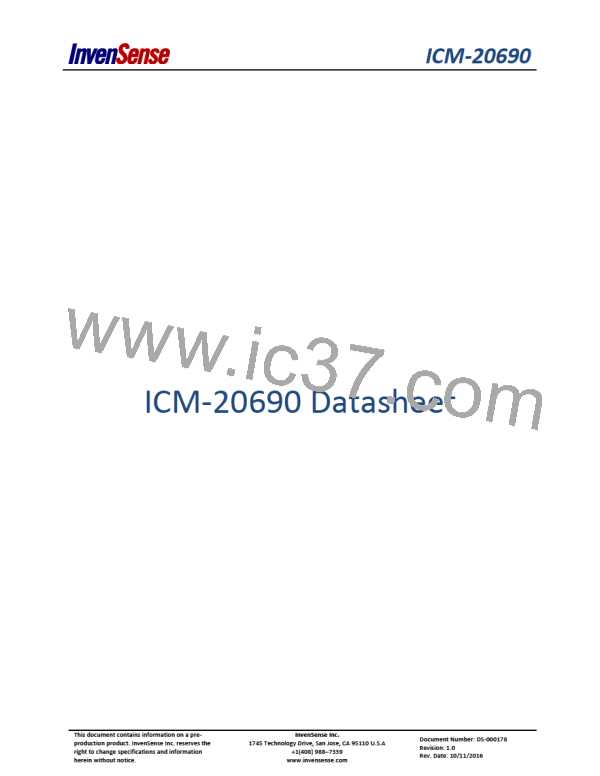ICM-20690
4.7 THREE-AXIS MEMS ACCELEROMETER WITH 16-BIT ADCS AND SIGNAL CONDITIONING
The ICM-20690’s 3-Axis accelerometer uses separate proof masses for each axis. Acceleration along a particular axis induces
displacement on the corresponding proof mass, and capacitive sensors detect the displacement differentially. The ICM-20690’s
architecture reduces the accelerometers’ susceptibility to fabrication variations as well as to thermal drift. When the device is placed
on a flat surface, it will measure 0g on the X- and Y-axes and +1g on the Z-axis. The accelerometers’ scale factor is calibrated at the
factory and is nominally independent of supply voltage. Each sensor has a dedicated sigma-delta ADC for providing digital outputs.
The full scale range of the digital output can be adjusted to ±2g, ±4g, ±8g, or ±16g for UI mode or to ±1g, ±2g, ±4g, or ±8g for OIS
mode.
4.8 I2C AND SPI HOST INTERFACE
The ICM-20690 communicates to the application processor using either a SPI or an I2C serial interface. The ICM-20690 always acts as
a slave when communicating to the application processor. The LSB of the I2C slave address is set by pin 1 (AD0).
4.9 SPI OIS INTERFACE AND AUXILIARY I2C INTERFACE
The ICM-20690 has an SPI interface for communicating to OIS controllers. This interface supports 3-wire SPI. The ICM-20690 always
acts as a slave when communicating to OIS controllers over this interface. The SPI interface is multiplexed with an auxiliary I2C bus
that can be used for communicating to off-chip sensors. This bus has two operating modes:
I2C Master Mode: The ICM-20690 acts as a master to any external sensors connected to the auxiliary I2C bus. The ICM-
20690 can directly access the data registers of external digital sensors. In this mode, the ICM-20690 directly obtains data
from auxiliary sensors without intervention from the application processor. The I2C Master can be configured to read up to
12 bytes from up to 3 auxiliary sensors.
Pass-Through Mode: The ICM-20690 directly connects the primary and auxiliary I2C buses together, allowing the application
processor to directly communicate with any external sensors connected to the auxiliary I2C interface. Pass-through mode is
useful for configuring external sensors.
4.10 SELF-TEST
Self-test allows for the testing of the mechanical and electrical portions of the sensors. The self-test for each measurement axis can
be activated by means of the gyroscope and accelerometer self-test registers.
When the self-test is activated, the electronics cause the sensors to be actuated and produce an output signal. The output signal is
used to observe the self-test response.
The self-test response is defined as follows:
Self-test response = Sensor output with self-test enabled – Sensor output with self-test disabled
When the value of the self-test response is within the specified min/max limits of the product specification, the part has passed self-
test. When the self-test response exceeds the min/max values, the part is deemed to have failed self-test.
4.11 CLOCKING
The ICM-20690 has a flexible clocking scheme, allowing a variety of internal clock sources to be used for the internal synchronous
circuitry. This synchronous circuitry includes the signal conditioning and ADCs, and various control circuits and registers. An on-chip
PLL provides flexibility in the allowable inputs for generating this clock.
Allowable internal sources for generating the internal clock are:
a) An internal relaxation oscillator
b) Auto-select between internal relaxation oscillator and gyroscope MEMS oscillator to use the best available source
The only setting supporting specified performance in all modes is option b). It is recommended that option b) be used.
Page 23 of 76
Document Number: DS-000178
Revision: 1.0

 TDK [ TDK ELECTRONICS ]
TDK [ TDK ELECTRONICS ]